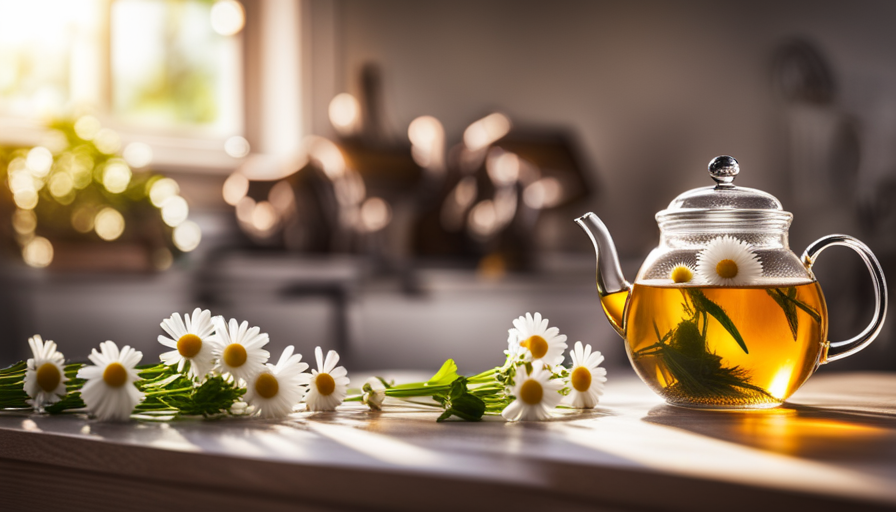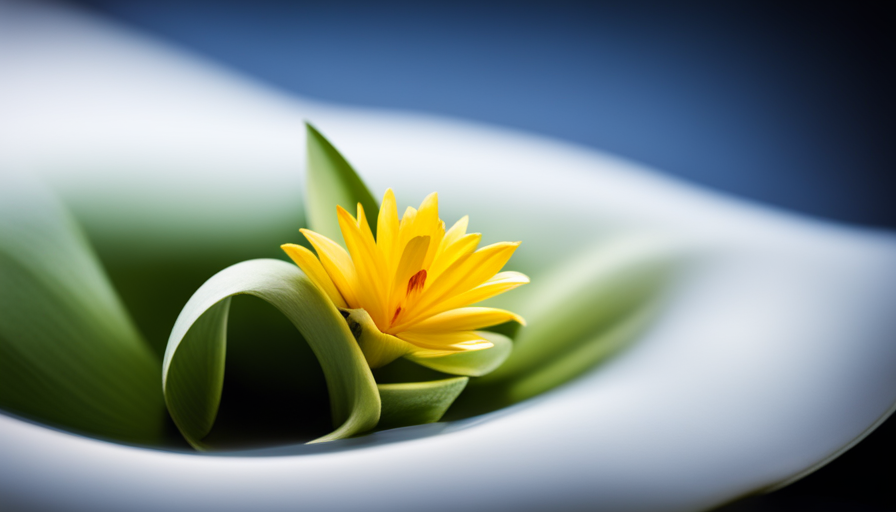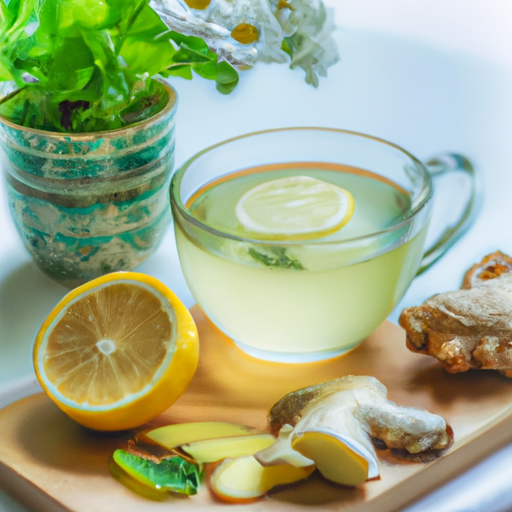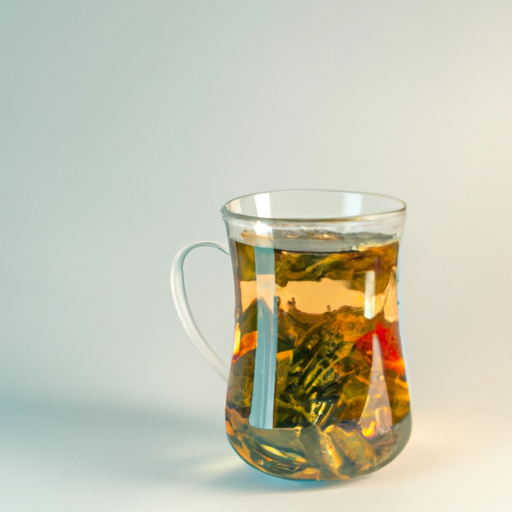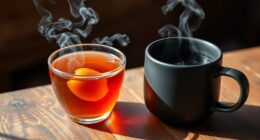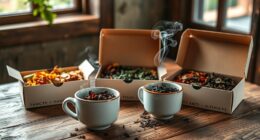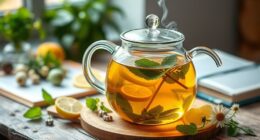Brewing herbal tea is akin to composing a calming melody for your palate. Similar to how a conductor meticulously chooses each instrument for seamless harmony, selecting the appropriate herbs is crucial in concocting a delicious cup of herbal tea.
In this article, I will guide you through the art of making herbal tea, step by step.
First, we will explore the vast array of herbs available, each with its unique flavors and healing properties. Then, armed with the necessary tools and ingredients, we will dive into the preparation process. From carefully measuring the herbs to infusing them with hot water, every step is crucial in extracting the full potential of the herbs.
To enhance the flavor and discover endless possibilities, we will also delve into techniques for adding a personal touch to your herbal tea. And of course, I will share tips on serving and storing your herbal tea, so you can enjoy a cup of tranquility whenever you desire.
So, let’s embark on this herbal tea journey together and uncover the wonders of nature’s healing brews.
Key Takeaways
- Choosing high-quality, organic herbs is essential for crafting a delightful cup of herbal tea.
- The right tools and water temperature are necessary for brewing tea.
- Measuring the herbs accurately ensures a well-balanced flavor.
- Experimenting with different blends allows for customization of herbal tea.
Choose Your Herbs
Now it’s time to start selecting your herbs for the perfect cup of herbal tea! When it comes to different types of herbal tea, the options are endless. Each herb brings its own unique flavor and benefits to the table.
For a calming and soothing cup of tea, chamomile is a great choice. It helps with sleep and relaxation, making it perfect for winding down after a long day.
If you’re looking to boost your immune system, echinacea is the way to go. It has properties that can help fight off colds and flu.
For a refreshing and uplifting cup of tea, peppermint is a popular choice. It aids digestion and can provide a burst of energy.
Other popular herbs for herbal tea include lavender, lemon balm, and ginger. Not only do these herbs add wonderful aroma and taste, but they also offer various health benefits.
So gather your tools and ingredients to continue on your journey to making the perfect cup of herbal tea.
Gather Your Tools and Ingredients
First, gather all the necessary tools and ingredients to create a delightful infusion of soothing and aromatic herbal goodness. Choose the right herbs that are crucial for a flavorful cup of herbal tea. Opt for high-quality, organic herbs that are free from pesticides and other harmful chemicals. Popular options include chamomile for its calming properties, peppermint for its refreshing taste, and lavender for its soothing aroma. Experiment with different combinations to find your perfect blend.
Using the right tools is equally important. You’ll need a teapot or a steeper to brew your tea. A steeper with a fine mesh is ideal for loose herbs, allowing the flavors to infuse properly. If you don’t have a steeper, a teapot with a built-in strainer will do the trick. Additionally, a measuring spoon or scale is useful for accurately measuring the herbs. Remember, using the right amount of herbs will ensure a well-balanced flavor.
Now that you’ve gathered your herbs and tools, you’re ready to move on to the next step: preparing your water.
Prepare Your Water
Little did you know that the water you choose to use can make or break the quality of your delightful infusion of soothing and aromatic herbal goodness. When it comes to making herbal tea, infusing techniques and water temperature play a crucial role in extracting the full flavor and medicinal properties of the herbs. To ensure a successful brew, it is important to prepare your water correctly.
Firstly, let’s talk about water temperature. Different herbs require different water temperatures to achieve optimal results. For delicate flowers and leaves, such as chamomile or mint, water heated to around 175°F (80°C) is ideal. This temperature allows the herbs to release their flavors without becoming bitter. On the other hand, for heartier herbs like lavender or rosemary, a higher temperature of around 200°F (93°C) is recommended to extract their robust essences fully.
Secondly, the quality of your water matters. Ideally, use filtered or spring water to avoid any unwanted flavors or chemicals. Tap water can sometimes contain chlorine or other impurities that might affect the taste of your herbal tea.
Now that you know how important water is, let’s move on to the next step and measure the herbs for the perfect cup of herbal tea.
Measure the Herbs
When measuring the herbs for herbal tea, it’s important to consider the recommended herb-to-water ratio. This ratio ensures that the tea isn’t too weak or too strong in flavor and potency.
Additionally, adjusting the amount of herbs used can be done to cater to personal taste preferences, allowing for a more customized tea experience. By following these guidelines, you can create a perfectly balanced and enjoyable cup of herbal tea.
Recommended Herb-to-Water Ratio
To achieve a delightful cup of herbal tea, it’s essential to use the perfect ratio of herbs to water. Different types of herbal teas require different herb-to-water ratios to bring out their unique flavors and benefits.
For lighter herbal teas like chamomile or mint, a ratio of 1 tablespoon of dried herbs to 8 ounces of water is recommended. This allows the delicate flavors to infuse gently without overpowering the senses.
On the other hand, stronger herbal teas like ginger or hibiscus may require a ratio of 2 tablespoons of herbs to 8 ounces of water for a bolder taste. Finding the right balance is crucial as it impacts the overall taste profile and potential health benefits of the tea.
Once the recommended ratio is established, we can move on to adjusting for personal taste preferences in the subsequent section.
Adjusting for Personal Taste
Finding the perfect balance of herbs and water allows me to customize the taste of my herbal infusion, creating a delightful cup that caters to my personal preferences. When adjusting for personal taste, there are two key factors to consider: steeping time and tea temperature.
Steeping Time
- Experiment with different steeping times to find your preferred strength of flavor.
- Longer steeping times generally result in a stronger and more intense infusion, while shorter steeping times produce a lighter flavor.
Exploring Different Tea Temperatures
- Try using different water temperatures to release different flavors and aromas from the herbs.
- Cooler water temperatures may yield a more subtle and delicate taste, while hotter water temperatures can bring out stronger and bolder flavors.
By adjusting steeping time and exploring different tea temperatures, you can create a herbal infusion that perfectly suits your taste preferences.
Now, let’s move on to the next section and learn how to infuse the herbs.
Infuse the Herbs
First, start by adding your desired herbs to a tea infuser, allowing their natural flavors to steep and create a delightful blend. Infusing techniques play a crucial role in extracting the health benefits and flavors of herbal tea. As the hot water surrounds the herbs, it breaks down the plant cells, releasing their essential oils, vitamins, and minerals into the water. This process is known as infusion, where the water becomes infused with the goodness of the herbs. It’s fascinating to witness how different herbs infuse and transform the water, creating unique flavors and therapeutic properties.
To help you visualize the variety of herbal infusions, here is a table showcasing some popular herbs and their benefits:
| Herb | Health Benefits | Flavor Profile |
|---|---|---|
| Chamomile | Soothes digestion | Floral, apple-like |
| Peppermint | Relieves headaches | Refreshing, minty |
| Lavender | Aids relaxation | Floral, earthy |
| Ginger | Eases nausea | Spicy, warming |
Experimenting with blends allows you to personalize your herbal tea experience. By combining different herbs, you can create a symphony of flavors and enhance the potential health benefits. So, let’s dive into the next section and explore the wonderful world of blending herbal teas.
Experiment with Blends
Mixing different herbs together creates a harmonious blend of flavors and health benefits, turning your cup of tea into a vibrant and revitalizing experience. Experimenting with different blend combinations allows you to customize your herbal tea to suit your taste and desired health benefits.
Combining herbs like chamomile and lavender creates a calming blend that promotes relaxation and sleep. If you’re looking for an immune-boosting blend, try mixing echinacea, elderberry, and ginger. This combination can help strengthen your immune system and ward off colds and flu. For a refreshing and digestive-aiding blend, consider combining peppermint and ginger. This blend can soothe an upset stomach and promote healthy digestion.
The possibilities are endless, and each blend offers its own unique set of benefits. By exploring different blend combinations, you can discover your favorite flavors and harness the power of herbs for improved well-being.
Moving on to the next step, enhancing the flavor of your herbal tea can be done in various ways.
Enhance the Flavor
To truly savor the full flavor experience of your herbal concoction, why not embark on a journey of exploration and discover the delightful art of infusing your brew? Add a hint of honey or a splash of citrus to transform it into a symphony of taste that dances on your taste buds like a jazz band playing a lively melody.
There are several ways to enhance the flavor of herbal tea and create unique blends that will tantalize your senses. Firstly, consider adding a touch of sweetness with honey. Not only does honey add a pleasant taste, but it also brings its natural health benefits to the mix. Choose a high-quality, raw honey to ensure the purest flavor.
Alternatively, you can experiment with different types of citrus fruits, such as lemon or orange, to add a zesty twist to your tea. The acidity and fragrant oils from the citrus peel will complement the herbal flavors and create a refreshing and invigorating brew.
Additionally, you can explore the world of spices and herbs to elevate the flavor profile of your tea. Consider adding a pinch of cinnamon, a sprig of fresh mint, or even a few crushed cardamom pods. These aromatic additions will infuse your tea with complexity and depth, taking it to a whole new level of taste sensation.
By incorporating these tips for creating unique herbal tea blends, you’ll be able to serve and enjoy a cup of tea that’s not only delicious but also a true work of art. So, let’s delve into the next step and discover how to serve and enjoy your perfectly crafted herbal tea.
Serve and Enjoy
Now that we’ve enhanced the flavor of our herbal tea, it’s time to serve and enjoy this delightful beverage. As a connoisseur of herbal tea, I can attest to the multitude of health benefits that it offers.
Herbal teas are known for their calming properties, aiding digestion, boosting the immune system, and promoting overall well-being. Each type of herbal tea provides its own unique set of benefits, so don’t be afraid to try different varieties to find the one that suits your needs. Some popular options include chamomile for relaxation, peppermint for digestion, ginger for nausea, and hibiscus for lowering blood pressure.
To serve and enjoy your herbal tea, follow these simple steps:
- Boil water in a kettle or pot.
- Place the desired amount of herbs or tea bags in a teapot.
- Pour the hot water over the herbs and let it steep for the recommended time.
- Strain the tea into your favorite cup and savor the aroma and taste.
Now that you know how to serve and enjoy your herbal tea, let’s move on to the next step: storing your herbs for future use.
Store Your Herbs
Preserving the freshness of your herbs is key to ensuring a delightful and invigorating experience every time you indulge in their aromatic goodness. Proper herb storage techniques are essential in maintaining the flavor, aroma, and medicinal properties of your herbal tea ingredients.
To preserve the freshness of your herbs, start by harvesting them at their peak, when the oils are most concentrated. Remove any damaged or wilted leaves, and gently wash the herbs to remove any dirt or insects. Once the herbs are clean and dry, store them in airtight containers away from direct sunlight and heat. Glass jars or metal tins with tight-fitting lids are ideal for preserving the freshness of your herbs.
Label each container with the name of the herb and the date of harvest to keep track of their freshness. Consider storing different herbs separately to prevent cross-contamination of flavors. By following these herb storage techniques, you can ensure that your herbal tea ingredients remain fresh and potent for future use.
Now, let’s explore herbal tea recipes that will allow you to fully savor the flavors and benefits of your carefully preserved herbs.
Explore Herbal Tea Recipes
Indulge in a delightful journey of flavors and aromas with these enchanting herbal concoctions that’ll transport your taste buds to a serene garden of tranquility and bliss.
-
Lavender Chamomile Tea: Savor the calming effects of lavender and chamomile, perfect for unwinding after a long day. This soothing blend promotes relaxation and aids in sleep.
-
Peppermint Tea: Refresh your senses with the invigorating taste of peppermint. Known for its digestive benefits, this tea is best enjoyed after a meal or during a midday slump to boost energy.
-
Ginger Turmeric Tea: Experience the warm and spicy notes of ginger and turmeric, a powerful combination that supports a healthy immune system and fights inflammation. Start your day with this revitalizing brew.
-
Lemon Balm Tea: Delight in the citrusy goodness of lemon balm tea. Its uplifting aroma and soothing properties make it an excellent choice to relieve stress and promote mental clarity.
Herbal tea benefits are abundant. Each blend offers unique advantages to enhance overall well-being. From promoting digestion to boosting immunity, these natural infusions provide a plethora of health benefits.
The best time to drink herbal tea varies depending on your needs. Enjoy a cup in the morning to kickstart your day or in the evening to unwind and relax before bed.
Embrace the power of nature and savor the goodness in every sip.
Frequently Asked Questions
Can I use dried herbs instead of fresh herbs to make herbal tea?
Yes, you can definitely use dried herbs instead of fresh herbs to make herbal tea. While using dried herbs may not provide the same intensity of flavor as fresh herbs, they still contain beneficial compounds that can infuse into the tea. However, it’s important to note that fresh herbs generally offer a more robust flavor profile and higher levels of essential oils, resulting in a more aromatic and flavorful tea. So if possible, using fresh herbs is recommended for a more satisfying herbal tea experience.
What is the best type of water to use when preparing herbal tea?
To make the best herbal tea, it’s crucial to use the optimal type of water. The temperature should be just right, around 200°F, to extract the full flavor and benefits from the herbs.
Filtered water is highly recommended as it removes impurities and enhances the taste. This ensures a cleaner, purer infusion, allowing the true essence of the herbs to shine through.
So, when preparing herbal tea, remember to choose filtered water for a delightful and refreshing brew.
How long should I let the herbs steep in the water?
When steeping herbs in water for herbal tea, it’s important to find the right balance. Letting the herbs steep for too long can result in a bitter taste, while steeping for too short a time may not extract enough flavor.
Different techniques can be used to achieve optimal steeping. For delicate herbs, such as chamomile or mint, steeping for 5-7 minutes is sufficient. However, stronger herbs like ginger or cinnamon may require steeping for 10-15 minutes to fully release their aromatic compounds.
Can I mix different herbs together to create my own unique herbal tea blend?
Absolutely! Mixing different herbs together to create your own unique herbal tea blend is a fantastic idea. It’s like being a master chef, experimenting with flavors to create a masterpiece.
Not only does it allow you to customize the taste to your liking, but it also opens the door to a wide range of health benefits. Each herb brings its own unique properties, so by mixing them, you can create a powerful concoction that targets specific health concerns.
How long can I store my herbal tea herbs before they expire?
Herbal tea herbs can be stored for varying lengths of time before they expire, depending on the type of herb and how it’s stored. To properly store herbal tea herbs, make sure they’re stored in a cool, dry place away from direct sunlight and moisture. It’s important to check for signs of spoilage, such as a change in color, texture, or smell. Expired herbs shouldn’t be consumed as they may have lost their potency and flavor.
Conclusion
In conclusion, making herbal tea is a delightful and rewarding process. By choosing the right herbs and following the proper steps, you can create a beverage that not only satisfies your taste buds but also offers numerous health benefits.
Through the infusion process, the herbs release their natural compounds, creating a harmonious blend of flavors and aromas. So why not embark on this herbal journey and explore the endless possibilities of herbal tea? It’s time to sip and savor the magic of nature’s remedies.

